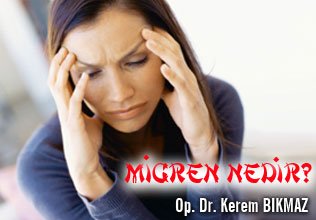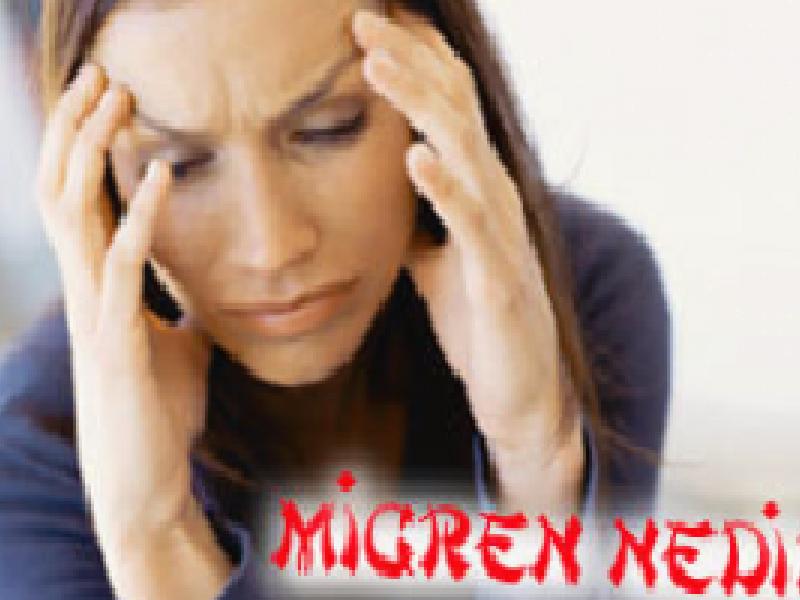
Headache is the most common cause of pain. Almost everyone experiences a headache. Most people get a headache at least once in any given year. For most people, headaches are a recurrent and significant problem.
MIGRAINE HEADHEAD CHARACTERISTICS
Typical migraine headache features are;
severe throbbing pain
nausea and sometimes vomiting
sensitivity to light, sound and smells
Migraine pain can affect one side of the head or the entire head. Headaches typically last 4-72 hours in adults, but can last for hours in children. Physical activity, walking and bending, etc. can worsen the pain.
Migraine headache frequency varies from person to person, sometimes it can be multiple times a month or 1-2 times a year or less frequently.
Usually, there is no headache between attacks. Some people may experience warning signs hours or days before a headache attack. These can be seen as excitement or intense energy, cravings for sweets, weakness, irritability or depression.
MIGRAINE TYPES
Migraine headaches are divided into two groups as with and without aura. Avra is a visual or sensory disturbance that disappears before and during a migraine headache. Avra starts an hour earlier and lasts for 15-60 minutes and ends when the headache starts. Typically, auras affect both eyes but can affect only one eye
Migraine euphoria includes the following findings:
Flashes and light beams,
flashes of light in geometric patterns such as zigzag lines or stars (usually seen with closed eyes) white, but may be colored)
slowly spreading blind spots or blurred vision
numbness, tingling of face or arms
difficulty speaking and word finding .
Most people with migraine headaches may not have aura. In some people, migraine attacks can sometimes be with or without aura. A very few people may have aura without headache. These are called migraine equivalents.
RISK FACTORS
Migraine can affect people of any age, but it is most common between the ages of 20-50. Its incidence is high in the family. 75% of affected people have a family history
The incidence in women is 2 times higher than in men. Migraine headache frequency and severity decrease in women over 50 years of age. Sometimes it can disappear after menopause.
REASONS
The exact cause of migraine headaches is unknown. Researchers; They believe as much as possible the role of change in serotonin and endorphin levels in the brain. Seratonin (a neurotransmitter) is a brain chemical that regulates pain transmitted via trigeminal nerve pathways. Trigeminal nerves are the main pathways for pain originating from the face, eyes, nose, sinuses, blood vessels and brain sheaths. Endorphins are natural pain-relieving chemicals produced by the brain and spin hord.
TRIGGERS
Most of the time, migraine headaches have no obvious cause, but fatigue, foods, environmental factors, minor head trauma, hormonal factors, and medications can trigger pain.
Factors triggering migraine headache;
+Diet-related factors
-Eating excessively or being hungry for a long time
– Some foods can trigger migraine headaches. These; alcohol, fermented-morine foods, artificial sweeteners (such as asportome), monosodium glutomate (common powder additive of Asian foods), caffeine, caffeine concentration, chocolate, aged cheeses, nitrates and nitrites (found in foods such as sausages), nuts and fruit juices .
+Environmental factors
– Climate and altitude change, exposure to bright lights, smoking, strong odors and noise can trigger migraine headaches
+Hormonal factors
It has been observed that changes trigger migraine headaches. In particular, migraine headaches tend to occur immediately before or during menstruation. Birth control pills and hormone replacement therapy can worsen migraine headaches. A reduction in migraine headaches during pregnancy is reported by most women. It has also been reported by most women that migraine headaches improve following menopause.
+Medicines
Some cardiovascular medications can worsen migraine headaches.
+Physical Factor
Changes in sleeping habits, sleeping too much or too little can trigger migraine headaches. Severe physical exertion, fatigue, acute head trauma can also trigger
+Sensory factors
Bright lights, smoke, strong smells and loud noise can trigger migraines.
+Stress
Stress or the passing of stress (weekend or travel) can cause migraine headaches.
DIAGNOSIS
If you have migraine headaches or have a family history of migraine, your healthcare provider will make a diagnosis based on your physical examination, medical history, and symptoms.
If you have extreme or severe migraine-type headaches, or if your headaches and neurologist symptoms are getting worse, certain tests may be recommended to rule out other causes of pain. These may be blood tests, brain imaging studies (homputerized tomography or magnetic resonance), eye examination and consultation with other branches.
Your doctor may ask you to keep a migraine diary. It should be noted when the migraine headache started, how long it lasted, the amount of pain, symptoms before, symptoms after or during it, and how the pain went away. Also, your triggers, medications and stress level in the 24 hours before the plug should be noted. This information is important in evaluating your treatment plan and response to treatment.
THERAPY
There are 3 general areas of effective treatment for migraine;
Avoiding migraine triggers
Acute treatment when migraine headaches
Preventive treatment
Although most migraine headaches do not have identifiable triggers, these should be tried to be distinguished and avoided. In this way, prevention and treatment of migraine pain is possible.
TREATMENT OF ACUTE ATTACKS
The most important factor in the treatment of migraine headache is to act quickly. The following approaches may be helpful in reducing pain and other symptoms.
Medications: Many medications can reduce pain and shorten migraine attacks. Ordinary painkillers (aspirin, acetaminophen, ibuprofen and naproxen) provide relief in mild to moderate migraine pain. Pain relievers should be used when necessary. Any pain reliever should not be taken more than twice a week. Overdose of painkillers; they lose their effectiveness, cause chronic daily headaches, cause stomach or intestinal pain or bleeding, ulcers, or serious kidney or liver damage. Consult your doctor if you need to increase the daily dose of painkillers.
If conventional painkillers do not improve your acute migraine pain; Your doctor may prescribe stronger medications. These are:
-Analgesics (pain medications)- single or combined
-Seratonin agonists (tryptones) Seratonin regulates pain messages in the brain, constricts swollen blood vessels in the scalp and prevents the release of substances that cause pain.
Examples: Sumatripton (Imigren), zolmitripton (zomig), eletripton (relpax) etc
Tryptones are the most effective drugs for acute headaches and have a low risk of side effects. Side effects; chest and/or neck pressure, pain, nausea, drowsiness, very rare heart attack. Therefore, those with coronary artery disease or those at risk should not use it.
Anti-nausea drugs: They are useful for nausea and even pain accompanying migraine.
All medicines can have unwanted side effects. Your doctor’s guidance may be best for you by trying multiple drugs or their doses. Discuss the benefits, side effects, and risks with your doctor.
“Caution: Some medications are not recommended if you are pregnant or breastfeeding. Some are not given to children. Your doctor can recommend the right medicine”
Rest and sleep: When a migraine headache starts, resting or taking a nap in a quiet or dark room reduces the severity of the attack and shortens its duration.
Physical techniques: Putting an ice pack on the neck or head can relieve pain. Massage of the head, neck and shoulder muscles may be helpful for some people.
Support groups: A therapist can teach techniques for coping with stress and pain
MIGRAINE PREVENTION
If you have severe or frequent migraine attacks, preventive treatment may be required.
Medications: These are taken daily regardless of pain. They can be given in combination with acute migraine attack drugs. They only give results in a few weeks or a month or two
Antidepressants: Tricyclic antidepressants (Amitriptyline etc.) can prevent migraine attacks.
Antihypertensive and cardiovascular drugs: Beta blockers (propronolol, atenolol), calcium channel blockers (verapamil) can reduce the frequency, severity and duration of migraine pain
Anticonvulsants: Sodium valproate, gabapentri and topiramate can prevent migraine pain .
Botox infections: With botulinum toxin infections in the forehead and skull muscles, the frequency, severity and duration of migraine headaches may decrease. After the infection, there is a temporary state of well-being that lasts for 3-4 months. In order for the benefit to continue, it is necessary to repeat the infections every 3-4 months.
Other substances: High doses of magnesium and riboflavin (vitamin B2) can reduce the frequency, severity and duration of pain. Always consult your doctor about using other medicines while taking them.
Biofeedback: Muscle biofeedback therapies provide information about muscle tension in different situations and provide relaxation. Methods of reducing muscle tension accompanying headache are shown.
Cognitive behavior therapy: Helps you become aware of typical headache triggers and reduce your reaction to anxiety and stress. Your headaches may decrease in number and intensity.
Relaxation training: Includes muscle relaxation, breathing exercises, and mental-contemplative visualization (therapy that assists imagining calming images). In this way, the frequency and intensity of headaches can be reduced.
PERSONAL CARE
Independent of preventive medications, lifestyle changes can also reduce the number and severity of migraine attacks.
Maintaining daily routine and order: Irregular sleep and eating habits can trigger migraine headaches. Excessive sleep or too little sleep can trigger migraines
Regular exercise: Regular aerobic exercise for at least 30 minutes 3 times a week reduces tension and reduces the frequency and severity of headaches. Swimming, walking and cycling can also be chosen.
Reducing the effects of estrogen: Women with migraine; If there is a family history of stroke, high blood pressure or vascular disease, estrogen-containing drugs (birth control drugs and hormone replacement therapy) should be avoided.

